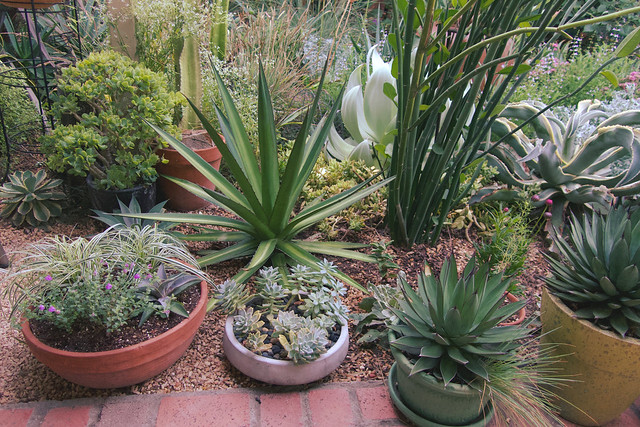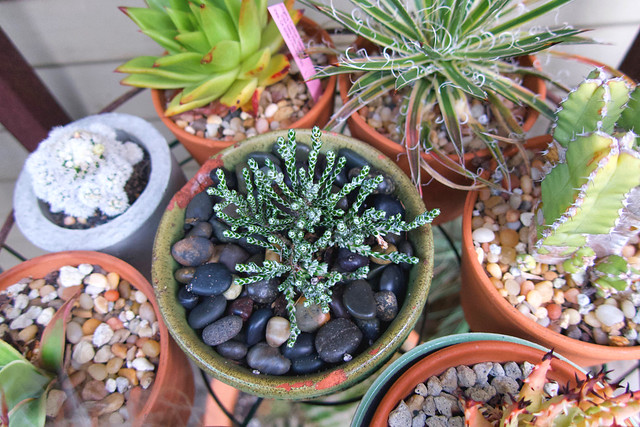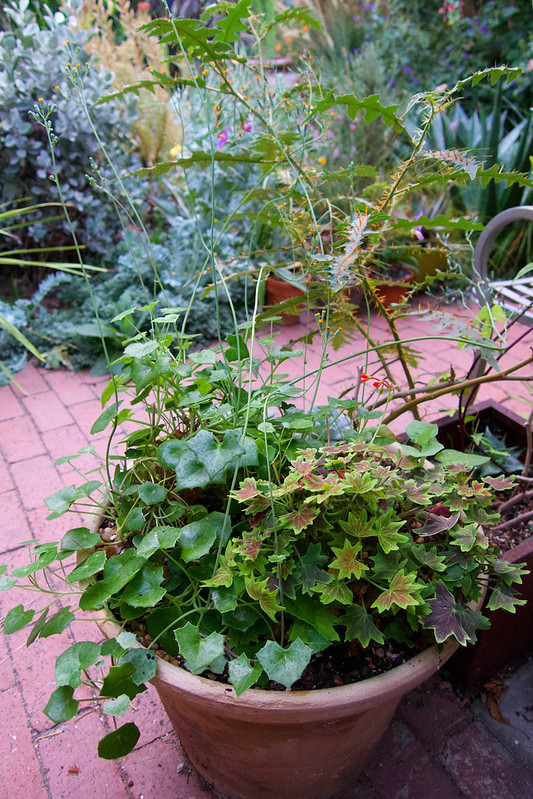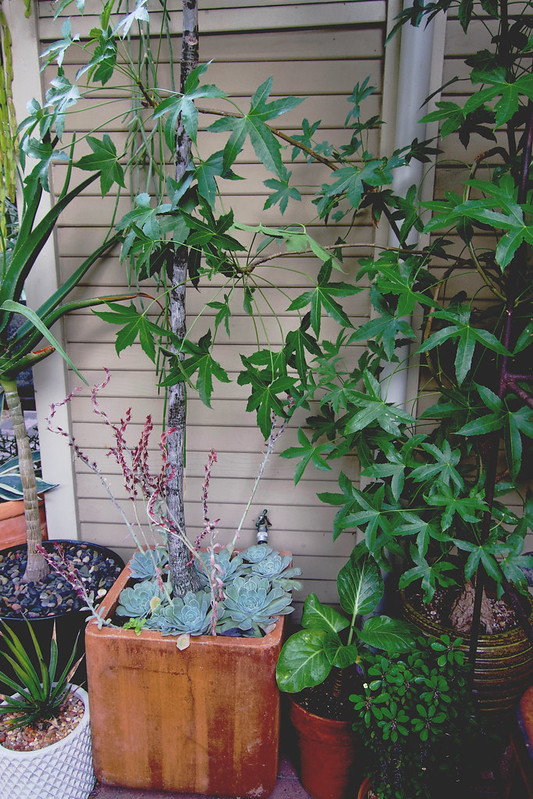More notes on micro-moves in my small back garden, mostly having to do with a succulent-forward mindset for fall/winter here in zone 10. If you scroll down to the previous post, where I mention having to move an aloe because Agave kerchovei was encroaching, here’s what actually transpired:
I moved the agave instead, giving a formerly potted Mangave ‘Mission to Mars’ its sunny spot in the garden.
The agave was moved to the base of the slipper plants, where the mangave, fabulous in its beehive pot, was holding court. I was very loath to move this agave for a couple reasons, not least of which was taking a chance with marring its slowly acquired beauty. But overriding even aesthetics, another crucial consideration was that of all my agaves, kerchovei has the meanest defenses. I get poked and scratched by plants all day long, but it is only with this agave that I’ve learned to drop what I’m doing, bathe the site with hydrogen peroxide and then hold it under running water for a minute or so, apply neosporin (the pain formulation), bandaid, and only then resume whatever I was doing. Otherwise, a welt quickly appears and with it a very unique, insistent pain that is impossible to ignore. If I act fast, there will be no welt or pain, but the site will still be sensitive and sore for a day or so.
All the low pots around the agave’s periphery were placed to keep those terminal spines well away from us as we walk by to do the laundry, sit under the pergola, etc. I did think about saying goodbye to the agave entirely (gulp!), but the move went without incident so it gets a reprieve for now. These soft-leaved mangaves that also make big architectural rosettes are going to be giving agaves a run for their money in the warmer zones, especially in small gardens where agave spine strikes can be a recurring problem.
And that nice big beehive pot that was home to the purple mangave? It came to the rescue of Mangave ‘Kaleidoscope’ that was being shaded by Salvia mexicana.
This mangave is supposed to live up to its name with eye-wateringly gawdy, red-streaked and flecked coloration in full sun, whereas mine is merely subdued variegation. I don’t mind losing all the color but that increasing shade will ultimately become a health problem for any succulent. I’ve also relocated Aloes scobinifolia, classenii, and gerstneri. Aloe classenii is known for its deep red leaf coloration in sun, and gerstneri’s blooms come encased in brown bracts that eventually drop to reveal the vibrant color beneath, a performance I’ve yet to see and am hopeful might happen next year in its new, sunnier location.
The salvia and Grevillea ‘Moonlight’ are the main shade instigators, along with Passiflora ‘Flying V’ clambering over them too. Late winter/early spring I plan to cut the salvia and passiflora back hard.
Agave ‘Snowglow’ is another refugee from increasing shade as the grevillea has gained garage-roof height. The agave was moved out over a year ago and has been slowly recovering, but it doesn’t have the perfect spherical geometry of one grown consistently in good light.
The birdbath’s temporary staging of silver dyckia has been removed and the dyckia will need a home to grow roots — pot or garden? Undecided. I thought I was done with rapidly increasing clumps of very scratchy terrestrial bromeliads so I’m still mulling this over. I would think the little Aloe ‘Rooikappie’ would be a favorite in colder gardens for overwintering indoors. Reblooms, smallish, lots of offsets if the mother plant gets too large.
Another variegated Euphorbia ammak was added to the mix of potted succulents. This one was dug up from a narrow strip along the east fence that will be renovated this year.
Need a little more distraction and plant talk? I don’t know about you, but I’ve got a broken tooth, the VP debates are tonight, and Marty is out of town — I’ll hang out here a little bit longer if that’s okay. I was looking up the provenance of bicolored Aloe ‘David Verity,’ first seen at the Huntington’s new entrance garden and bought at one of their plant sales, and San Marcos Growers’ entry says it originates with “Boyd Walker, who grew out some of Dave Verity’s hybrids at his Pacific Palisades garden.” Now, I’ve read that entry many times, but this time I was intrigued enough by Mr. Walker and his Pacific Palisades garden, about 30 miles north of me near Santa Monica, to do some investigating. Was the garden still there? Unknown. Mr. Walker died in 2001, and his UCLA memoriam doesn’t even mention the aloe work of this Battle of the Bulge survivor, famed ichthyologist, grunion expert, and authority on Zuni fetishes. A single life is a wondrous thing. I did find an article Robert Smaus wrote for the Los Angeles Times in 1990, back in the newspaper’s horticultural heyday, that gives a glimpse of his garden in words with some specific advice on caring for echeverias:
“To ensure that all energy goes to producing the leaves, Walker pinches back the echeverias’ flowers, and every year he cuts rosettes from the stems, lets them dry out in the air for a few days, then re-roots them in empty pots. Once roots appear, he transplants them into soil. He picks a pot that is as big in diameter as the rosette; when the leaves overhang the sides by 2 inches, he moves it into a larger pot. His soil mix is simplicity itself: 1 part garden soil, 1 part sand, 1 part perlite and 1 part compost from his own pile. He fertilizes the plants several times a year. Old stems, by the way, are saved. Little plantlets sprout along the lengths of the old stems, and these are eventually severed off and rooted.” — “A Winter Palette : Succulents Provide Brilliant Color During the Coldest Months, Usually the Dreariest Time in the Garden” by Robert Smaus, Los Angeles Times, 1/14/90
















Who knew there was a Grunion expert ? I can’t remember how we knew they were running-I guess the same way surfers know Mavericks is up. Or maybe it was in the Times.
I have a few Mangave Kaleidoscope pups and I am going to put one in the shade (though snail danger is high) to see what happens to the color. It also became clear to me that I need to do some rain protection in winter. Thanks to some concrete removal I have some shelter options now.
Agave kerchovei, with which I’m entirely unfamiliar, sounds vicious and I think I’ll just step away should I ever encounter it. Your Mangaves – and all your succulents – look healthy and happy. I love that Ozothamnus coralloides. I bought 3 a few years ago and two died fairly promptly while one hung on for a few years, seemingly never getting any larger. I think you were smart to put it in a pot, allowing it to be admired as a special specimen.
You have been busy. The mangaves look they will settle in nicely. It’s that you are preparing for the growing season while I am putting everything inside and to bed for the year. In the third photo there is a large silvery grey plant in the background in front of the urn. What is it? It’s gorgeous.
@Kathy, apparently they were unstudied before Boyd took them on. Very exciting new projects you’re taking on this fall.
@Kris, that ozotham is so slow growing I decided to treat it like a potted succulent.
@Elaine, that’s Agave celsii var. albicans. Such a beauty.
I think it’s time I give up on my Mangave ‘Kaleidoscope’ ever looking as good as yours…
That’s a lovely post, stuffed full of plant talk. Made me forget all the bad stuff.
Thank you!
The garden looks the best I can remember, showing the benefits of your skilled attention and (for many of the succulents) a few season’s growth. Truly, “The best fertilizer is the gardener’s shadow.”
We’re having the last few toasty days before a cold front moves in, and I’m finally able to get out for brief viewing stints (recovering from surgery). The garden is pretty shaggyy but still full of interest, particularly for this gardener whose shadow has been absent for the whole season. The strong structure comes through the base of resurgent seedy grasses. I’d give a lot right now for a small team of energetic garden help; in three days, it could be ready for winceless winter gazing…
The managaves are magnificent. I can see why they are getting so hothothot now.
@Nell, I hope your recovery is going well! Take it slow, you’ll be good as new in no time. I picked up another mangave just a couple days ago, a variegated ‘Navajo Princess.’ I was going to plant my potted Agave weberi ‘Arizona Star’ but just can’t deal with another 7-foot wide agave at this point, so the much smaller mangave got its place in the garden.
@Loree, the Kaleidoscope starting picking up red tints after just a few days in the sun. Of course, it’s been in the 90s…
@Hoov, we have to continue to entertain each other! I appreciate your efforts as well.